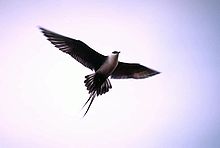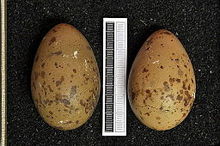Long-tailed jaeger: Difference between revisions
replaced deprecated cite template parameters |
|||
| Line 38: | Line 38: | ||
{{reflist}} |
{{reflist}} |
||
* {{cite book | last = Harrison | first = Peter | title = Seabirds of the World | year = 1996 | publisher = Princeton University Press | location=Princeton | isbn = 0-691-01551-1}} |
* {{cite book | last = Harrison | first = Peter | title = Seabirds of the World | year = 1996 | publisher = Princeton University Press | location=Princeton | isbn = 0-691-01551-1}} |
||
* {{cite book | last = Bull | first = John | |
* {{cite book | last = Bull | first = John | last2 = Farrand, Jr. | first2 = John | title = The Audubon Society Field Guide to North American Birds, Eastern Region |date=April 1984 | publisher = Alfred A. Knopf | location=New York | isbn = 0-394-41405-5 }} |
||
==External links== |
==External links== |
||
Revision as of 16:00, 12 May 2015
| Long-tailed jaeger | |
|---|---|

| |
| Scientific classification | |
| Kingdom: | |
| Phylum: | |
| Class: | |
| Order: | |
| Family: | |
| Genus: | |
| Species: | S. longicaudus |
| Binomial name | |
| Stercorarius longicaudus (Vieillot, 1819) | |
The long-tailed jaeger (Stercorarius longicaudus) (known as the long-tailed skua outside the Americas) is a seabird in the skua family Stercorariidae.
This is the smallest of the skua family at 38–58 cm (15–23 in), depending on season and age. However up to 29 cm (11 in) of its length can be made up by the tail which may include the 15 cm (5.9 in) tail streamers of the summer adult. The wingspan of this species ranges from 102 to 117 cm (40 to 46 in) and the body mass is 230–444 g (8.1–15.7 oz).[2][3]
This species breeds in the high Arctic of Eurasia and North America, with major populations in Russia, Alaska and Canada and smaller populations around the rest of the Arctic. It is a migrant, wintering in the south Atlantic and Pacific. Passage juvenile birds sometimes hunt small prey in ploughed fields or golf-courses, and are typically quite fearless of humans.
Two subspecies are listed:[4]
- S. l. longicaudus – (Vieillot, 1819): northern Scandinavia and Russia.
- S. l. pallescens – (Løppenthin, 1932): eastern Siberia, Arctic North America, and Greenland.

They nest on dry tundra or higher fells laying two spotted olive-brown eggs. On the breeding grounds they can be heard making yelping and rattling sounds. Outside of the breeding season they spend most of their time over open ocean and have a harsh kreeah cry. This bird feeds on fish (mainly caught from other seabirds), smaller birds, food scraps, small mammals, fruit and carrion. On migration, long-tailed jaegers are more likely to catch their own food, and less likely to steal from gulls and terns than larger species.

This species is unmistakable as an adult, with grey back, dark primary wing feathers without a white "flash", black cap and very long tail. Adults often hover over their breeding territories. Juveniles are much more problematic, and are difficult to separate from parasitic jaeger over the sea. They are slimmer, longer-winged and more tern-like than that species, but show the same wide range of plumage variation. However, they are usually colder toned than Arctic, with greyer shades, rather than brown.
References
- ^ Template:IUCN
- ^ CRC Handbook of Avian Body Masses by John B. Dunning Jr. (Editor). CRC Press (1992), ISBN 978-0-8493-4258-5.
- ^ "Long-tailed jaeger videos, photos and facts - Stercorarius longicaudus". ARKive. Retrieved 2011-10-20.
- ^ "Coursers, noddies, gulls, terns, skuas and sandgrouse". International Ornithological Congress. Retrieved 2015-01-12.
- Harrison, Peter (1996). Seabirds of the World. Princeton: Princeton University Press. ISBN 0-691-01551-1.
- Bull, John; Farrand, Jr., John (April 1984). The Audubon Society Field Guide to North American Birds, Eastern Region. New York: Alfred A. Knopf. ISBN 0-394-41405-5.
External links
- Oiseaux Photo, plates
- Avibase
 Media related to Stercorarius longicaudus at Wikimedia Commons
Media related to Stercorarius longicaudus at Wikimedia Commons Data related to Stercorarius longicaudus at Wikispecies
Data related to Stercorarius longicaudus at Wikispecies- Stercorarius longicaudus in Field Guide: Birds of the World on Flickr


